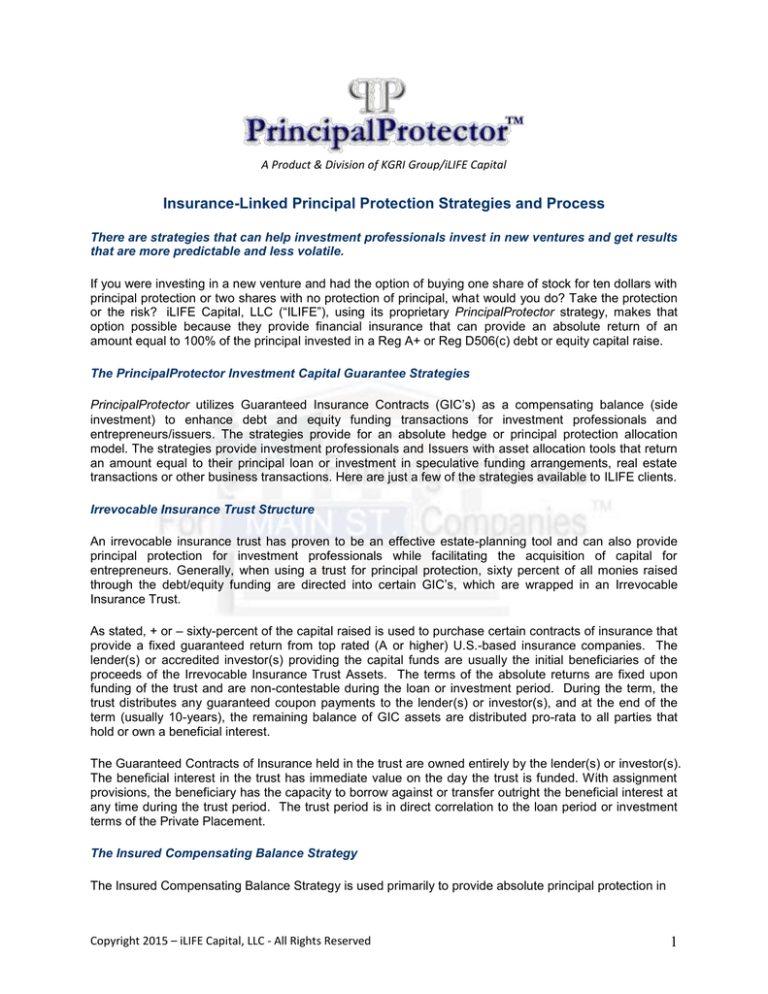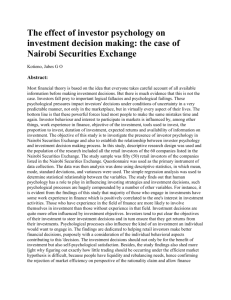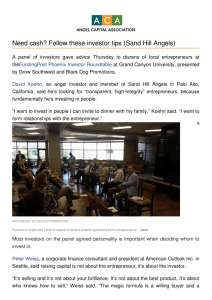
A Product & Division of KGRI Group/iLIFE Capital
Insurance-Linked Principal Protection Strategies and Process
There are strategies that can help investment professionals invest in new ventures and get results
that are more predictable and less volatile.
If you were investing in a new venture and had the option of buying one share of stock for ten dollars with
principal protection or two shares with no protection of principal, what would you do? Take the protection
or the risk? iLIFE Capital, LLC (“ILIFE”), using its proprietary PrincipalProtector strategy, makes that
option possible because they provide financial insurance that can provide an absolute return of an
amount equal to 100% of the principal invested in a Reg A+ or Reg D506(c) debt or equity capital raise.
The PrincipalProtector Investment Capital Guarantee Strategies
PrincipalProtector utilizes Guaranteed Insurance Contracts (GIC’s) as a compensating balance (side
investment) to enhance debt and equity funding transactions for investment professionals and
entrepreneurs/issuers. The strategies provide for an absolute hedge or principal protection allocation
model. The strategies provide investment professionals and Issuers with asset allocation tools that return
an amount equal to their principal loan or investment in speculative funding arrangements, real estate
transactions or other business transactions. Here are just a few of the strategies available to ILIFE clients.
Irrevocable Insurance Trust Structure
An irrevocable insurance trust has proven to be an effective estate-planning tool and can also provide
principal protection for investment professionals while facilitating the acquisition of capital for
entrepreneurs. Generally, when using a trust for principal protection, sixty percent of all monies raised
through the debt/equity funding are directed into certain GIC’s, which are wrapped in an Irrevocable
Insurance Trust.
As stated, + or – sixty-percent of the capital raised is used to purchase certain contracts of insurance that
provide a fixed guaranteed return from top rated (A or higher) U.S.-based insurance companies. The
lender(s) or accredited investor(s) providing the capital funds are usually the initial beneficiaries of the
proceeds of the Irrevocable Insurance Trust Assets. The terms of the absolute returns are fixed upon
funding of the trust and are non-contestable during the loan or investment period. During the term, the
trust distributes any guaranteed coupon payments to the lender(s) or investor(s), and at the end of the
term (usually 10-years), the remaining balance of GIC assets are distributed pro-rata to all parties that
hold or own a beneficial interest.
The Guaranteed Contracts of Insurance held in the trust are owned entirely by the lender(s) or investor(s).
The beneficial interest in the trust has immediate value on the day the trust is funded. With assignment
provisions, the beneficiary has the capacity to borrow against or transfer outright the beneficial interest at
any time during the trust period. The trust period is in direct correlation to the loan period or investment
terms of the Private Placement.
The Insured Compensating Balance Strategy
The Insured Compensating Balance Strategy is used primarily to provide absolute principal protection in
Copyright 2015 – iLIFE Capital, LLC - All Rights Reserved
1
order to mitigate the capital risk of a loan in a debt transaction or investment in an equity transaction.
Plus/minus sixty-percent of accredited investors capital, from the Issuer private placement, is invested
into guaranteed insurance contracts (GIC’s), which mature within a 10 - 15 year term. The lenders or
investors are insured/protected against loss of their principal, plus they may actually receive gains from
accumulated tax deferred interest accumulation, and/or the excess cash values of the GIC’s. The GIC’s
are underwritten by an A.M. Best A or better insurance company and the lenders or investors are the
beneficiaries of the proceeds.
The remaining forty-percent of the lender or investor capital is invested into the business or venture of the
Issuer on whatever terms and conditions are agreed upon in the private placement memorandum (PPM).
If the business/venture should fail and its assets have a zero value, the compensating balance GIC’s
return a minimum of 100% of the lender/investor principal, on an absolute basis, and within a fixed term
certain.
Normally the guaranteed contracts of insurance are for a 10 to 15 term and are structured on a "bullet/end
of term" basis for the return of principal. The structure typically provides an annual lender/investor
coupon of 4% to 7% and allows them to obtain 100% of their investment principal at the end of term, not
withstanding any equity holdings or other returns in the business or venture.
Normally, an insurance-linked PrincipalProtector strategy within a Reg A+ or Reg D506(c) PPM will
translate to less or no equity forfeited by the Issuer – “How much equity is no risk worth?”
The benefit to the Issuer is that they are able to "reach" capital sources for a higher risk business or
venture that would otherwise not be available for the company/issuer, and on better terms. This is an
excellent strategy for risk adverse investment professionals and during times of high market volatility – it
provides safety and security of capital investments.
The paragraphs that follow outline the typical steps for structuring and implementing an Insurance-Linked
PrincipalProtector Strategy (“IPS”), which takes the typical risk out of lending or investing capital.
The IPS was developed to help provide safety and security for accredited investors investing in new or
emerging companies. This strategy encourages investors to invest in ventures that they previously would
have avoided because of the risks involved. Entrepreneurs that have utilized similar PrincipalProtector
strategies have found it easier to raise capital because of the benefits offered to investors.
What is the IPS?
The IPS is based upon the concept of setting aside a portion of invested capital to provide a hedge, or
insurance, against loss or total loss if a business or venture is unsuccessful. The capital that is set aside
is sometimes referred to as a sinking fund or compensating balance investment. This compensating
balance is invested in insurance-linked products that can offer an absolute fixed and a variable rate of
return that will enable this side investment of capital to eventually grow to an amount equal to the original
principal investment and provide a reasonable return, even if the portion of capital invested in the
business/venture returns zero.
In the past, investment bankers utilizing a sinking fund concept have invested these side funds in zerocoupon bonds and other conservative fixed products. Although these strategies offer an attractive asset
allocation model there are several disadvantages. The first is if the fund is not structured or segregated
properly it is subject to bankruptcy or attack by creditors and it lacks tax favorable portability or
transferability for exchange or option purposes. Second, the investment products typically utilized in the
sinking fund either provide low yields to maturity or they are subject to current taxes or accretion… all of
which extend the time period of the fund to reach the required or desired maturity value.
Copyright 2015 – iLIFE Capital, LLC - All Rights Reserved
2
The concept of setting something aside, or establishing a reserve or accumulation fund, as a form of
insurance is nothing new. The first recorded case of a hedge or reserve fund is told in Genesis 41:46-54
where Joseph stored up grain in Egypt during the years of plenty to provide for the years of famine.
Investment professionals have been using reserve funds to provide additional security for investors and
credit enhancement for lenders for some time.
Venture & Investors
PPM Agreement
$5M
$3M Principal
Investment
Insurance
Trust
Invests in Guaranteed
Insurance Contracts
$2M Principal
Investment
Funds
Double*
over 10-Yr
fixed date
certain.
Plus annual
earnings
per agreed
$5M Principal
Investment Returned
plus earnings
$XXXK Profits (ROI)
Per Deal Terms
Business / Venture
Investor Receives a Blended
Return with Absolute 100%
Return of Principal Investment
Through GIC’s and has
Flexible Options
* Rule of 72 – 72 Divided by the IRR = # Yrs.
Note: The Rule of 72 also goes back to Biblical days told about in the Gospels of the story of The
Parable of the Talents where the master gave his servants money and the servants were instructed to “do
business” with the money entrusted to them. The element of time was applied, as the man goes to
another country, stays a long time, and then returns. It states two of the servants doubled the money his
master entrusted to him (by smartly & safely investing it).
So What Makes the IPS Unique?
The IPS is unique because it utilizes a trust and insurance contracts to segregate and/or guarantee the
value of the whole through just the portion of the compensating balance investment. The funds are
invested in guaranteed contracts of insurance offered by top-rated A and better U.S.-based insurance
companies rather than lower yielding products that are subject to greater market risk. The investment
instruments are largely uncorrelated to volatility in the markets as they pay out the same in up or down
markets. The IPS also offers transfer options that provide significant benefits for investors and
entrepreneurs.
What is a Trust?
A trust is a fiduciary relationship in which property is held by one or more persons for the benefit of one or
more persons. The person creating a trust is generally called the grantor. The grantor typically executes a
Copyright 2015 – iLIFE Capital, LLC - All Rights Reserved
3
trust document and transfers property to the person who will be responsible for administering the terms of
the trust who is called a trustee. The person for whose benefit the trustee administers the trust is called a
beneficiary. The property held in trust is often called the trust corpus or trust assets (these are the GIC’s).
The trust may provide for management of property, accumulation or distribution of income to beneficiaries,
distribution of trust assets to beneficiaries, withdrawal powers for beneficiaries and other powers of
appointment.
The grantor typically creates a trust by executing a trust document and transferring property (GIC assets)
to the trustee. The trust is created for the benefit of beneficiaries. In the case of these compensating
balance GIC assets, each GIC asset is individually wrapped in a separate Trust (or sub trust) so as they
mature, the Trustee as per the terms, can disburse them to the beneficiaries. This also allows for greater
flexibility, in that certain of the GIC assets may be hypothecated, pledged, monetized, encumbered,
assigned, transferred, or other possible options, to provide shorter-term liquidity for the lender/investor
and provide flexible options to mitigate any GIC asset-class risks (if any).
A trust must have a trustee of legal capacity. A trust must have assets; that is, it must hold property. A
trust must have a custodian of the assets such as a bank or other legal entity. A trust must have one or
more beneficiaries of legal capacity. A beneficiary may be either a specified person, a member of some
ascertainable class of persons, or a charity.
How does the Insurance-Linked PrincipalProtector Trust Strategy (IPS) Work & How is it
Managed?
The Irrevocable Trust document, explains the responsibilities of the parties, and is a legal document. The
lender or investor by executing the Subscription Agreement of the Issuer PPM utilizing the IPS, agrees to
have a portion of the capital investment deposited into a dedicated Escrow Account managed by iLIFE
Capital, LLC (Trustee and Asset Manager), who then facilitates the purchase of the guaranteed contracts
of insurance and Trust wrapper. The GIC assets mature on an absolute basis to pay the trust an amount
equal to his or her principal investment in a specified number of years, whether or not the Issuer's
company or venture succeeds or fails.
Unlike zero-coupon bonds and other dubious financial instruments, guaranteed contracts of insurance
offer tax-deferred accumulation and higher yields thereby accelerating the trust's growth. A custodian or
bank holds the trust, and the investor’s beneficial interest in the trust is not subject to bankruptcy or
creditor claims of other investors, the Issuer or the company issuing its securities. Additionally, the
beneficial interest in the trust can be hypothecated, pledged, monetized, encumbered, assigned, or
transferred to accommodate a number of investor-issuer benefits without liquidating the pool of
guaranteed contract of insurance and precipitating unfavorable tax consequences.
The IPS eliminates the worst-case investment scenario... full loss of principal with no return or income. It
enables investors to have the best of both worlds...safety and potentially significant returns from new or
higher risk investments. Additionally, the flexibility of the trust allows for numerous exit strategies by the
investor. These options and benefits encourage investors to invest in ventures that heretofore they might
have avoided.
The IPS Offers Flexibility
Once established, the trust flexibility provides for the assignment of beneficial interest, assignment of
trustee, change in custodian and early exit strategies.
Some of the many early exit strategies include a stock exchange option for investors, a deferred
compensation option for entrepreneurs/issuer and early trust distribution options for the benefit of both
parties.
Copyright 2015 – iLIFE Capital, LLC - All Rights Reserved
4
The PPM can also be written to provide investors other flexible options allowing them to opt out of the
principal protection (in part or the whole) and double down on their equity position (if offered) - see The
Adjustable Private Placement Offering Option (APO) further below.
A well-known broker dealer in California said in an Investor’s Business Daily article, “The real genius of
the program is a provision that lets investors opt out of the trust and double down on their investment at
the original share price if the start-up looks like it's going to succeed. It almost sounds too good to be
A well-known broker dealer in California said in an Investor’s Business Daily
true."
article, “The real genius of the program* is a provision that lets investors opt out of
the trust and double down on their investment at the original share price if the
start-up looks like it's going to succeed. It almost sounds too good to be true."
How Can I Use These Strategies?
You might be able to develop strategies similar to the IPS and implement a trust and source the purchase
of guaranteed contracts of insurance (with the proper metrics & management) or you can access our turnkey iLIFE Capital System fully supported by our investment banking team, and save a lot of time and
money. Over two years and hundreds of thousands went into developing and perfecting the original
InvestorProtector, now PrincipalProtector, and a significant amount of additional time and capital has
gone into our latest proprietary IPS solution. Over a couple hundred principal protected Trusts have been
successfully implemented.
ILIFE can help you implement the right principal protection strategy and a successful capital raise for a
fraction of the cost it would take you to go through the learning curve and try to duplicate our system
yourself. In Today's Marketplace, Investors want Absolute Returns, No Risk of Principal, and Liquidity in
their Investments. Our Turn-Key System of Self-Issuer Private Placement with Principal Protection (iLIFE
Capital System), is absolutely the best alternative to Effectively
Raising Capital Today...Period! We
Provide Marketable Deal Structures that attract investors. An SEC compliant and proven capital raising
system that enables you to SUCCESSFULLY RAISE CAPITAL!
We know of no other capital raising system offering absolutely everything required to implement and
successfully complete a private placement, and one which provides an investor principal protection
feature with attractive flexible options.
We are helping investors and entrepreneurs to fund new ventures
Investors and entrepreneur/issuers have successfully utilized the IPS to fund new ventures, and the
program* has been featured and recognized in the financial media and promoted by Inc., Fast Company,
Entrepreneur and The Wall Street Journal.
The GIC assets we use have been successfully used for hedging risk by Berkshire Hathaway, AIG, ABN
AMRO, Merrill Lynch, Credit Suisse First Boston, & Deutsche Bank, who have invested hundreds of
millions in GIC assets. Many pension funds like California Public Employees Retirement System
(CalSTRS) have also invested millions and millions in GIC assets, as has Yale, Stanford & Harvard
Endowment Funds.
Please keep in mind ILIFE DOES NOT RAISE YOUR CAPITAL…You are a Self-Issuer and ONLY
Licensed Broker Dealers or Bona-fide Employees of the Issuer can talk to potential Investors – we set
you up for the greatest degree of success as a self-issuer and “Shepherd” you through the process,
providing you with all the tools and resources required to be in SEC compliance and successfully conduct
and complete your capital raise. We develop all required documents and presentations and guide you
through the capitalization process. Additionally, we actively manage the compensating balance assets for
the life of the Issuer’s PPM term and act as Trustee to carryout the terms. We get paid through the
success of your capital raise and management of compensating balance assets, so we have every
Copyright 2015 – iLIFE Capital, LLC - All Rights Reserved
5
incentive to make sure your capital raising effort is a success. If we don’t think it has the highest
chance of being successful, we simply will not take the Issuer on as a client.
Jed Graham in a December 19, 2001 article in Investor’s Business Daily said, “The InvestorProtector*
plan gives ultimate safeguard: money-back guarantee. And now, despite the risk-averse funding climate,
the InvestorProtector* program, is already helping start-up firms raise cash.”
Jed Graham in a December 19, 2001 article in Investor’s Business Daily said,
* program is also appealing to Angel investors, venture capital firms and investment
The InvestorProtector
“The plan
gives ultimate safeguard: money-back guarantee. And now, despite
professionals. the
Bruce
Blechman,
co-author climate,
of Guerrilla
andisfounder
The Capital
Institute,
risk-averse funding
theFinancing
program,
alreadyof helping
start-up
firms
* program is the
America's largest
financing
advisory
firm
for
small
business
says,
"The
InvestorProtector
raise cash.”*
first program I've seen that takes the risk out of risk capital.”
The program is also appealing to Angel investors, venture capital firms and
An author of Financing and securities counsel for a broker-dealer who has prepared over 700 Private
investment He
professionals.
Bruce
co-author
Guerrilla
Financing
Placement Memorandums.
says, “The program
is Blechman,
a solid strategy
that helpsof
investors
participate
in and
founder
of
The
Capital
Institute,
America's
largest
financing
advisory
firm for
super ventures."
small business says, "The program is the first program I've seen that takes the
risk out of risk capital.”*
An author of Financing and securities counsel for a broker-dealer who has
prepared over 700 Private Placement Memorandums. He says, “The program is a
solid strategy that helps investors participate in super ventures."*
The IPS Solution Connects Entrepreneurs/Issuers with Investors
By proactively promoting and informing accredited investors of the options they have through the
utilization of the IPS, we significantly increase the funding resources and opportunities for
entrepreneur/issuers and provide a new investment paradigm for investors. No other investment banking
services firm has as powerful of a proven strategy to serve as a compelling catalyst in bringing
entrepreneurs and investors together.
The IPS solution is exclusively the property of and marketed & distributed by iLIFE Capital, LLC.
Certain ILIFE consultants, affiliates and strategic partners also serve as investment banking advisors and
are authorized to provide our funding products, tools and resources for entrepreneurs/issuers and for
investors. Check directly with ILIFE to verify those relationships.
The Adjustable Private Placement Offering Option (APO) – Adjustable Risk ~ Adjustable Return
In the Adjustable Life Insurance concept, one can adjust from Whole to Term or Term to Whole Life in
whatever incremental percentage desired, and it also allows for an increase or decrease in the amount of
coverage and cash values. In a similar way, the Adjustable Private Placement Option (APO) can be
structured to provide investors the flexibility of adjusting from Debt (Notes) to Equity (Common or
Preferred Stock) and can offer full principal protection (albeit lower returns) to no principal protection and
potentially higher returns. The way this would work, is in a Notes offering with a stated coupon, the
Principal Protection feature would be convertible to Equity (or an increased percentage of Equity if Notes
with Equity kicker structure), which then would provide only partial principal protection if partially, or fully
convertible to Equity which then forfeits the protection…all in, it can accommodate whatever incremental
adjustments are desired by the investor…you control the amount of risk in your investments…you
control the amount and type of return!
iLIFE Capital, LLC is the developer and exclusive provider of this proprietary Adjustable Private
Placement Offering feature, providing the investor an Adjustable Debt to Equity Deal Structure for Private
Placement Offerings, allowing the investor to begin with a deal structure of Insured Convertible Notes with
Copyright 2015 – iLIFE Capital, LLC - All Rights Reserved
6
stated coupon, that is fully or partially Convertible to Common or Preferred Equity (could be in any
percentage of Debt to Equity), within a one year period. In this deal structure scenario, the Adjustable
Private Placement Offering initially provides the investor 100% principal protection secured with beneficial
interest in the GIC assets, and allows the investor to convert any portion of the insured principal
protection, for a greater value in Common or Preferred Stock Equity (with fractional to no protection), if
things look like they are going well in the company in which they invested, at any time within the first year.
So, they would convert their Insured Notes to Uninsured Common Stock Equity - the beneficial interest of
the GIC would be transferred to the benefit of the company/venture/issuer. A sliding scale (see
illustration below) can even be structured to convert a certain percentage of the Insured Notes (keeping a
certain %) for Equity and keeping some of the GIC protection. Thus, it is possible they can convert all or
any portion their Notes and retain the some Principal Protection, or convert all of the Notes and GIC into
the Common Stock Equity of the company.
Example A: Investor Jones makes a $100K investment in NewCo Private Placement Offering (Reg D
506c) - $40K goes into NewCo for Insured Convertible Notes with a 5% Coupon. $60K is invested into the
GIC assets. After 11 months Jones feels the company is stable and no longer as high of a risk as when
he originally invested, and converts all Notes including the beneficial interest in the GIC into Common
Stock Equity. He transfers his beneficial interest in the GIC Trust to the company (issuer) and essentially
doubles down on the venture investment equity side. Investor Jones no longer has the principal protection,
as he has converted that option into Equity, after being afforded the opportunity to see the early
performance of the company for one year, before making that decision.
Example B: Same structure of investment as above, however Investor Jones only converts half of his
Notes to Common Stock Equity, retaining the other $20K of his investment in the 5% Insured Notes, and
also retains the principal protection only on that portion. He now has a blended return - 5% on $20K of
Insured Notes and Equity dividends from $20K converted to the company Common or Preferred stock.
Note: This can be used to hedge a Going Public promise of the Private Placement Offering, if the
company succeeds in using some of the initial capital to trigger an IPO, they can then convert out of the
Notes (or Preferred) and GIC protection into the going-public Common stock, just prior to the IPO, if the
going public play fails to occur (for any reason, controllable or uncontrollable), they still have all the
options as stated above in a private company. They can actually have their cake and eat it too!
The APO is an attractive deal structure for a PPM and provides potential investors the best of all options,
making it more likely for them to invest – it places them in control over their own investment.
DEBT NOTE
WITH COUPON
FULL
PROTECTION
DEBT NOTE
WITH COUPON
FULL
PROTECTION
DEBT NOTE
WITH COUPON
FULL
PROTECTION
Copyright 2015 – iLIFE Capital, LLC - All Rights Reserved
EQUITY
COMMON STOCK
NO
PROTECTION
EQUITY
COMMON STOCK
NO
PROTECTION
EQUITY
COMMON STOCK
NO
PROTECTION
7
IPS Implementation Process & Procedures
The IPS structure offers a unique financial model that is blended with insurance industry products to
provide capital protection for investors, and a more marketable offering for the entrepreneur/issuer in a
private placement transaction. The IPS structure offers lenders and investors’ safety for an absolute
return of principal when investing in speculative funding arrangements, real estate transactions or other
business transactions.
Generally, sixty-percent of all capital raised through a debt or equity (or other hybrid deal structure) is
directed into guaranteed contracts of insurance which are wrapped in an irrevocable Insurance trust. The
lender(s) or investor(s) providing the funds will be the initial beneficiaries of the GIC assets through the
Irrevocable Insurance Trust. The terms of the returns are fixed upon funding of the trust and are not
contestable during the term or investment period. At the end of the investment period, the trust
distributes the principal proceeds to all parties that hold or own a beneficial interest. The trust also
provides periodic payments of any fixed coupon structured into the terms of the private placement offering.
The beneficial interest of the lenders/investors in the trust has immediate value on the day the trust is
funded. With assignment provisions, the beneficiaries have the capacity to borrow against or transfer
outright their beneficial interest at any time during the trust period. Generally the trust period will be for a
period of 10 – 15 years, for the doubling of funds to occur. The duration is dependent on the growth of
the funds.
Steps or Process Involved in Implementing the IPS and iLIFE Capital Solution
1.
iLIFE will review the current executive summary, business plan, pro forma, executive bios, aswell-as website, and conduct certain due diligence, prior to inviting business/venture principal(s) to
participate in the IPS iLIFE Capital Solution program.
2.
For approved businesses/ventures an iLIFE Capital - iLIFE Capital Solution Consulting & Assets
Management Agreement will be completed and signed by the parties prior to the commencement of any
work.
3.
In the capacity of a consultant to Client, iLIFE provides Client all of the services, resources and
deliverables of the iLIFE Capital System and Shepherd's the Client through a capital raise to its
successful completion (see details in separate iLIFE Capital Solution Brochure which can be downloaded
at www.iLIFECapital.com).
4. In the capacity of the Asset Manager, iLIFE (or its assigns) structures the compensating balance
assets to fit the requirements of the PPM, sources the GIC assets, coordinates all necessary documents,
acts as Trustee of the Irrevocable Insurance Trust, pays the premiums, coordinates the capital
requirements for the investor PPM coupon, Manages the GIC assets et. al., for the term required by the
PPM.
Copyright 2015 – iLIFE Capital, LLC - All Rights Reserved
8
Investor Benefits
Investors don’t care if the Issuer needs to raise twice
as much – what they are looking for is:
a. The fact that a diversified investment is likely a
safer investment.
b. The return ON their investment, not necessarily
the business they are investing in.
c. The fact that an Issuer thought to protect their
investment – most other investments are a risk.
d. That they have options they normally don’t have,
like doubling down on the Equity (convertible option)
side by trading-in the protection after a one-year look.
e. That in a worse case 100% of their principal is
protected – no down side only up-side. Eliminates
the worst-case investment scenario... full loss of
principal with no return or income. It enables
investors to have the best of both worlds...safety and
potentially significant returns from new or higher risk
investments.
f. That in a best case they have a blended (higher)
return from kicker returns from participation in deal
structure of business or venture.
g. They can invest in a non-correlated alternative
with absolute returns which they would not be able to
invest in on their own, because we have provided the
opportunity via investing along side of many others
making it feasible.
h. From the investor point of view the flexible
options in the GIC side provide liquidity not normally
possible in private placement investment due to
restrictions in Rule 144. The beneficial interest in the
GIC trust can be hypothecated, pledged, monetized,
encumbered, assigned, or transferred to
accommodate a number of investor benefits without
liquidating their position in the pool of guaranteed
contracts of insurance.
i. Allows investors to invest in ventures they may
like, but have previously avoided because of the risks
involved.
Entrepreneur/Issuer Benefits
a. Issuer: “This means I will need to raise double
the capital - ”That assumes you can raise any capital
at all without having an absolute return on the
Principal.
b. You are providing a sophisticated Wall St
structured finance model as a Main St company that
most Private Placement Issuers don’t have the
opportunity to offer their investors…this makes your
opportunity stand out in the crowd. The GIC assets
we use have been successfully used for hedging risk
by Berkshire Hathaway, AIG, ABN AMRO, Merrill
Lynch, Credit Suisse First Boston, & Deutsche Bank,
as well as by pension funds like California Public
Employees Retirement System (CalSTRS) and by
Yale, Stanford & Harvard Endowment Funds.
c. If the investor(s) convert, the IssuerCo gets the
gain on their books of the value of the GIC – the
higher value making it easier to attract further capital.
d. If the investors don’t convert, you have provided
them a higher return without the return burden being
on your business – their entire principal return is
coming from the side investment not out of the Issuer
resources.
e. Per point (c) the Issuer has options with the GIC
- the beneficial interest in the GIC trust can be
hypothecated, pledged, monetized, encumbered,
assigned, or transferred to accommodate a number
of issuer benefits without liquidating the assets.
f. It makes you issue easier to sell to investors
because of the investor benefits list on the left.
g. If your business or venture is one of higher
investor risk, you can still attract investors because
you are protecting their core investment from loss.
h. Using the Principal Protector strategy the Issuer
gives up less Equity (Common Stock control)
because “How much Equity is no risk worth”
i. It’s the only good option for Start-ups and Early
Stage companies who have little to no track record
and no collateral assets to pledge as it encourages
investors to invest in ventures that they previously
would have avoided because of the risks involved.
Important Note: The structured strategies discussed above are intended to only be used as part of a
properly drafted Private Placement Memorandum under a Reg D 506(c) Blue Sky exemption or Reg A+
offering, which has legal review for compliance.
Copyright 2015 – iLIFE Capital, LLC - All Rights Reserved
9
Wall St. Solutions for Main St. Companies
Adjustable Risk & Returns
Insured PrincipalProtector
We Have The Money Puzzle Covered
Professional PPM & Presentation Docs
Saas Funding Platform for Investor/Issuer
Investment Banker Coaching & Oversight
James R. Nash
KGRP Group / ILIFE Capital
(231) 645-2526
JRNash@KGRIGroup.com
www.KGRIGroup.com
www.iLIFECapital.com
Social Media Platform Attracting Investors
ILIFE Capital – self-issuer Licensed Investment
solutions to Fund Enterprise
Investor Marketing & Media Services Attracting $’s
iLIFE Capital, LLC (iLIFE) nor KGRI Group are a United States Securities Dealer or Broker or licensed U.S.
Investment Adviser. Nothing in this communication is to be construed as an offer to sell, nor a solicitation of an offer
to purchase any securities. An offering is made only by the prospectus. Any materials referenced herein and
provided or produced by IiLIFE are examples and specimens for illustrative purposes only. Clients are advised to
have all documents produced by iLIFE reviewed by qualified legal counsel. Disclaimer: iLIFE, its affiliates and alliance
partners make no guarantees or warranties express or implied that iLIFE clients will obtain any funding as a result of
the use of its products or services.
* Quotes used herein about IPS were made about its predecessor InvestorProtector for which iLIFE Capital retains the international
licensing rights. For use in the U.S. the name has been changed to PrincipalProtector. Mr. Nash CEO of KGRI Group was a Clevel executive with the InvestorProtector in the early 2000’s.
Copyright 2015 – iLIFE Capital, LLC - All Rights Reserved
10







